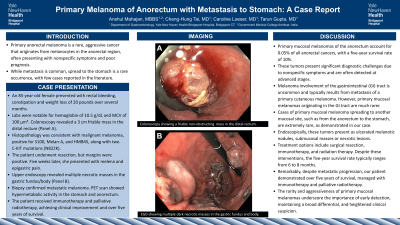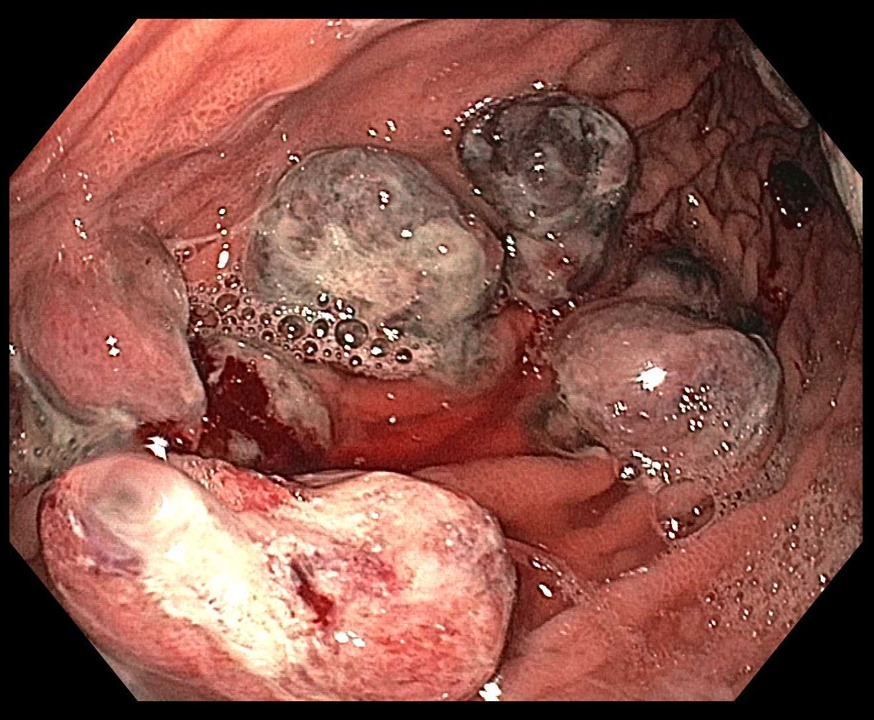Tuesday Poster Session
Category: GI Bleeding
P4245 - Primary Melanoma of Anorectum with Metastasis to Stomach
Tuesday, October 29, 2024
10:30 AM - 4:00 PM ET
Location: Exhibit Hall E

Has Audio

Anshul Mahajan, MBBS
Government Medical College and Hospital
Trumbull, CT
Presenting Author(s)
Anshul Mahajan, MBBS1, Cheng-Hung Tai, MD2, Caroline Loeser, MD2, Tarun Gupta, MD3
1Government Medical College and Hospital, Trumbull, CT; 2Yale New Haven Health, Bridgeport Hospital, Bridgeport, CT; 3Yale New Haven Health, Bridgeport Hospital, Trumbull, CT
Introduction: Primary malignant melanoma of the anus and rectum constitutes 0.05% of all anorectal malignancies. It is a rare and highly lethal malignancy associated with a very poor prognosis due to its aggressive nature and tendency to metastasize to various organs. We present a case of primary mucosal melanoma of the anorectum with gastric metastasis, a rare occurrence of an uncommon disease.
Case Description/Methods: An 85-year-old female presented with several months of rectal bleeding and pain along with constipation and weight loss. Her physical examination was unremarkable. Laboratory values were significant for hemoglobin of 10.5 mg/dl and MCV- 100μm3. Colonoscopy revealed a polypoid friable non-obstructing medium-sized mass at the distal rectum. Histopathology of the biopsy showed morphology and immunophenotype consistent with malignant melanoma positive for S100, Melan A, and HMB45. Patient underwent complete surgical resection. The pathological specimen showed anorectal junction with positive deep and lateral margins. Five weeks postoperatively, the patient presented with new onset epigastric pain and melena with a hemoglobin of 9.5 mg/dl. Her EGD revealed multiple 10-30mm, dark pigmented, semi-sessile polyps/masses in the gastric fundus and body [Figure 1]. Biopsies from these lesions revealed malignant melanoma. Reports from a previous EGD conducted 7 months ago for upper abdominal pain did not show any such mucosal lesions. PET-CT scan revealed increased metabolic activity limited to stomach and anorectum. Diagnosis of metastatic gastric malignant melanoma from primary anorectum was made. Patient was referred to oncology and was started on combined immunotherapy with single-agent nivolumab along with palliative radiotherapy to the stomach. Following this, she showed clinical improvement and slow disease progression which led to a remarkable five-year survival milestone despite metastasis.
Discussion: Primary mucosal melanomas although rare are aggressive, with a five-year survival of only 10%-20%. Vigilance is required as symptoms can be nonspecific, leading to delayed diagnoses. This case highlights the importance of maintaining a broad differential for polypoid or ulcerating masses occurring at GI tract requiring endoscopic biopsies and histopathology for diagnosis.

Disclosures:
Anshul Mahajan, MBBS1, Cheng-Hung Tai, MD2, Caroline Loeser, MD2, Tarun Gupta, MD3. P4245 - Primary Melanoma of Anorectum with Metastasis to Stomach, ACG 2024 Annual Scientific Meeting Abstracts. Philadelphia, PA: American College of Gastroenterology.
1Government Medical College and Hospital, Trumbull, CT; 2Yale New Haven Health, Bridgeport Hospital, Bridgeport, CT; 3Yale New Haven Health, Bridgeport Hospital, Trumbull, CT
Introduction: Primary malignant melanoma of the anus and rectum constitutes 0.05% of all anorectal malignancies. It is a rare and highly lethal malignancy associated with a very poor prognosis due to its aggressive nature and tendency to metastasize to various organs. We present a case of primary mucosal melanoma of the anorectum with gastric metastasis, a rare occurrence of an uncommon disease.
Case Description/Methods: An 85-year-old female presented with several months of rectal bleeding and pain along with constipation and weight loss. Her physical examination was unremarkable. Laboratory values were significant for hemoglobin of 10.5 mg/dl and MCV- 100μm3. Colonoscopy revealed a polypoid friable non-obstructing medium-sized mass at the distal rectum. Histopathology of the biopsy showed morphology and immunophenotype consistent with malignant melanoma positive for S100, Melan A, and HMB45. Patient underwent complete surgical resection. The pathological specimen showed anorectal junction with positive deep and lateral margins. Five weeks postoperatively, the patient presented with new onset epigastric pain and melena with a hemoglobin of 9.5 mg/dl. Her EGD revealed multiple 10-30mm, dark pigmented, semi-sessile polyps/masses in the gastric fundus and body [Figure 1]. Biopsies from these lesions revealed malignant melanoma. Reports from a previous EGD conducted 7 months ago for upper abdominal pain did not show any such mucosal lesions. PET-CT scan revealed increased metabolic activity limited to stomach and anorectum. Diagnosis of metastatic gastric malignant melanoma from primary anorectum was made. Patient was referred to oncology and was started on combined immunotherapy with single-agent nivolumab along with palliative radiotherapy to the stomach. Following this, she showed clinical improvement and slow disease progression which led to a remarkable five-year survival milestone despite metastasis.
Discussion: Primary mucosal melanomas although rare are aggressive, with a five-year survival of only 10%-20%. Vigilance is required as symptoms can be nonspecific, leading to delayed diagnoses. This case highlights the importance of maintaining a broad differential for polypoid or ulcerating masses occurring at GI tract requiring endoscopic biopsies and histopathology for diagnosis.

Figure: Figure 1: EGD revealing multiple necrotic dark pigmented masses with ulceration in the stomach
Disclosures:
Anshul Mahajan indicated no relevant financial relationships.
Cheng-Hung Tai indicated no relevant financial relationships.
Caroline Loeser indicated no relevant financial relationships.
Tarun Gupta indicated no relevant financial relationships.
Anshul Mahajan, MBBS1, Cheng-Hung Tai, MD2, Caroline Loeser, MD2, Tarun Gupta, MD3. P4245 - Primary Melanoma of Anorectum with Metastasis to Stomach, ACG 2024 Annual Scientific Meeting Abstracts. Philadelphia, PA: American College of Gastroenterology.
